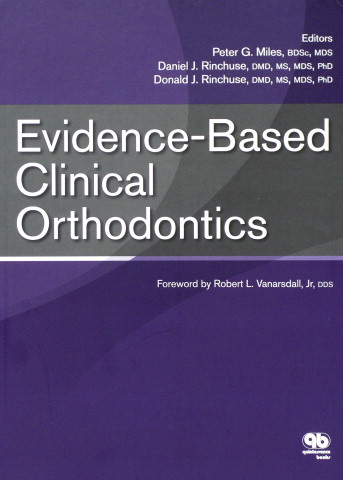
Peter Miles and coeditors Daniel and Donald Rinchuse are experienced orthodontic educators and clinicians. Peter Miles is a senior lecturer in the Department of Orthodontics at the University of Queensland in Brisbane, Australia. Donald Rinchuse is professor and program director, and Daniel Rinchuse is a professor and associate director of the graduate orthodontic program, at Seton Hill University in Greensburg, Pa.
The purpose of this book is to provide the clinician an evidence-based approach to current orthodontic issues. The orthodontic topics are well chosen, and each chapter is illustrated with high-quality images. The text is easy to read, and the numerous references reflect the ability to search electronic databases, as overviewed in chapter 1.
The authors correctly stated that we have few prospective well-designed randomized clinical trials in orthodontics. The classic Class II randomized clinical trials in the United States and the United Kingdom still comprise the best evidence for early intervention in Class II malocclusion, yet controversies persist, as indicated in chapter 2. Additionally, marketing to the public and the specialist allows some of the best available evidence to be ignored.
Major technologic advances in biomaterials science have translated into clinical practice with superelastic aligning archwires and bracket adhesives extensively covered in chapters 3 and 4. The next 3 chapters focus on Class II and Class III malocclusions and asymmetries.
Interestingly, the application of cone-beam computerized tomography in orthodontic diagnosis and treatment planning is only briefly mentioned, although there are systematic reviews and the SEDENTEXCT guidelines for orthodontics. Sleep apnea is also excluded, even though orthodontists are delivering oral appliances and systematic reviews have been published.
Chapters 8 and 13 cover temporary anchorage devices and accelerated tooth movement, and chapter 9 covers the risk indicators and interceptive treatment of maxillary canines. Root resorption from biologic and patient management perspectives is followed by temporomandibular disorders in chapter 11. Relapse, stability, and retention are covered in chapter 12.
Compared with other similar texts, this textbook gives the clinician a well-illustrated and easy-to-read format. It is not concerned with providing the skills to conduct a systematic review of the literature and critically evaluate new information, but with the application of current evidence to selected clinical topics; it does this well.
Stay updated, free dental videos. Join our Telegram channel

VIDEdental - Online dental courses


